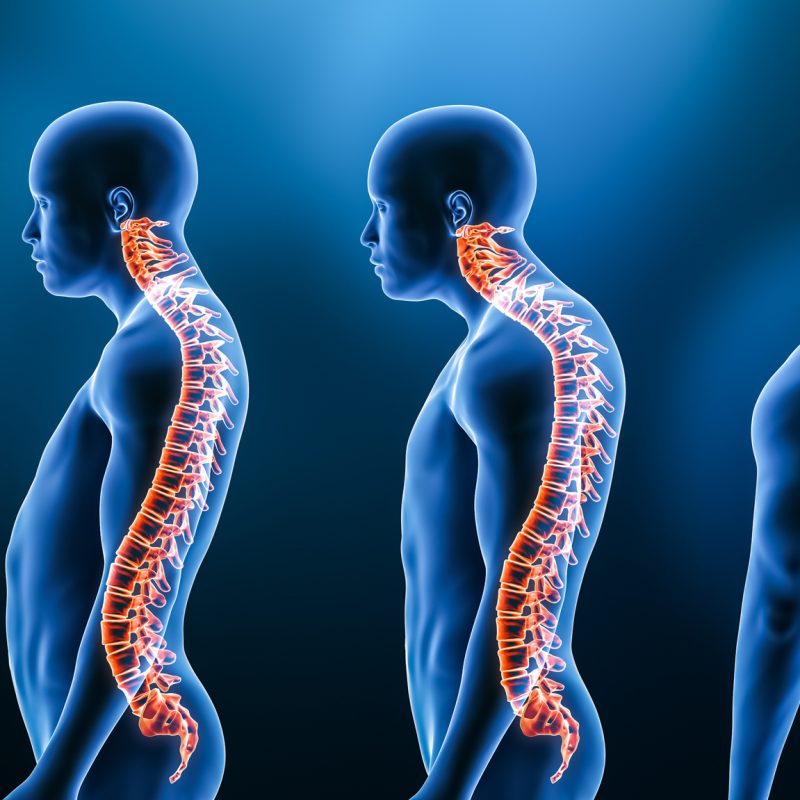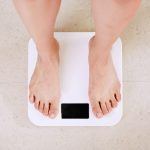
The human spine consists of natural curves, beautifully designed to keep us comfortably upright and maintain proper posture. However, too much curvature can lead to both physical and physiological health concerns. In this article, we review the various aspects of kyphosis, including its appearance, diagnosis, and the different surgical and less invasive treatment methods.
Kyphosis Defined
A diagnosis of kyphosis means the spine’s curves exceed their natural boundaries. Excessive curvature causes the upper back to bend forward, typically in the thoracic region (between the neck and the ribcage). Often referred to as a hunchback condition, kyphosis often presents as slouching/hunching over. Such excessive mechanics can pose great problems aside from self-consciousness regarding one’s appearance; kyphosis can cause pain and difficulty breathing, often requiring surgical intervention.
Varying Degrees of Kyphosis
The medical community has delineated several different manifestations of kyphosis, depending upon the condition’s severity. These include the following:
Postural kyphosis ~ this typically strikes during one’s teen years. Habitual slouching/poor posture tends to stretch the ligaments and muscles responsible for keeping the vertebrae properly aligned. This stretching in turn, pulls the vertebrae so far out of their normal position that a rounding of the spine ensues. The condition does not tend to cause pain at this point in one’s life. Postural kyphosis seems more prevalent among teenage girls than boys.
Scheuermann’s kyphosis ~ this diagnosis comes as a result of misshapen vertebrae; instead of developing in the usual rectangular shape, the vertebrae appear wedge-shaped. These oddly shaped vertebrae consequently cause forward spine curvature, resulting in the rounded, hunchback presentation. Contrary to postural kyphosis, Scheuermann’s affects more males than females and can elicit pain, particularly when one stands or sits for extended periods of time. Since vertebrae lack flexibility, altering one’s posture or stance cannot change the curvature.
Hyperkyphosis (Thoracic kyphosis) ~ common after age 40, this category represents a severe forward curvature of the spine, in excess of 50 degrees. Typically, the forward angle of an individual’s upper spine tends to increase by as much as 3 degrees every 10 years; as such, hyperkyphosis plagues 20-40% of adults after the age of 60.
Cervical kyphosis ~ also known as “military neck”, occurs as a result of the cervical spine (from the bottom of the head to the upper portion of the back) curving toward the front of the body instead of following its natural backward curve.
Congenital kyphosis ~ diagnosed at birth (or perhaps in utero if it appears on a sonogram), congenital kyphosis means the spine failed to develop completely or properly during pregnancy. This form of kyphosis tends to increase in severity with age. If surgically corrected during childhood, doctors can prevent the condition from worsening. Often, congenital kyphosis accompanies other birth defects, such as those affecting the kidneys and the heart.
Recognizing Symptoms
As we mentioned earlier, kyphosis can cause more than just rounded shoulders or a humped appearance of the upper back. Patients often complain of tight hamstrings, numbness/weakness/tingling in the legs, difficulty breathing (due to lung compression), balance instability/difficulty walking, excessive fatigue, and, in severe cases, bladder/bowel incontinence.
Kyphosis versus Scoliosis
While both of these conditions affect the spine, they present very differently in terms of anatomical structure. They can present concurrently, but one does not lead to the other.
Kyphosis refers to the spine’s abnormal curvature from the front of the body to the back, whereas scoliosis appears as an abnormal curve of the spine sideways, from the left to the right. Many grade schools conduct routine scoliosis exams on students in an effort to catch the condition early; once a child sees his pediatrician for a more complete diagnosis, the doctor often finds signs of kyphosis as well.
As part of diagnosing, a pediatrician will have the child stand straight with feet together, arms hanging naturally at the sides, and knees straight but not locked. Then he will have the child bend forward, with eyes on his feet; in this position, the physician can visualize any spinal curvature issues.
Early Detection, Treatment and Prevention
Adolescents show a greater susceptibility to postural disorders such as thoracic kyphosis, most likely due to the increased use of digital devices. Constant focus on cell phones and computers causes them to adopt improper postures that can further exacerbate pre-existing structural deformities.
The Cobb angle, considered the current gold standard method for determining kyphosis, originated as a means of assessing scoliosis angles. By modifying the direction of radiographic imaging from frontal to sagittal projection, the Cobb measurement now correctly identifies kyphosis angles. The fourth thoracic vertebra (T4) cannot often be detected due to over-projection of other structures; given this challenge, doctors choose to measure the Cobb angle by drawing a line through the superior endplate of T4 and a second line through the inferior endplate of T12. The Cobb angle lies at the intersection of these two lines.
In adolescents, the normal thoracic angle ranges from 20°–40°; a diagnosis of thoracic kyphosis means the angle of the curve exceeds 40°. In rapidly growing adolescents with thoracic kyphosis, abnormal thoracic-spine flexion can impede the development of the internal organs and interfere with normal respiratory function, and can also increase intradiscal pressure, which alters the load distribution on the spine.
Young people, typically those in their early teen years, can take some simple preventative measures to avoid postural kyphosis. These can include:
- Practicing good posture, whether standing or sitting
- Keeping the abdominal muscles and back muscles strengthened
- Maintaining an appropriate body weight and composition
- Engaging in regular full-body exercise to keep the body flexible
- Appropriately carrying school books/supplies, balancing weight distribution with a solid backpack, or opting instead to use a roller bag
Despite one’s best efforts, sometimes the aforementioned tips do not make a significant enough difference; teens with mild/moderate kyphosis may need to wear a back brace for several months. The brace, most often necessitated with a diagnosis of Scheuermann’s kyphosis, stabilizes the bones while still in their active growth stage of development, to prevent the curvature from worsening. Typically, the spine’s growth ceases by ages 14-15, at which point the individual no longer needs the back brace.
Addressing the Adult Diagnosis
Even without specific diseases, the natural aging process can cause gradual changes in the spine that lead to increased curvature. Weakening of vertebral bones due to osteoporosis can lead to compression fractures, causing them to collapse and increase the curvature. Also, as intervertebral discs dry out and shrink with age, they lose their cushioning ability. This process, referred to as degenerative disc disease, causes adults to lose height with age. Weakening of the back and core muscles with age can also contribute to poor posture and an increased curvature of the spine.
One study on kyphosis in adults revealed a significant correlation between anterior disc height and kyphosis angle, and a negative correlation to age. This led scientists to place disc degeneration as merely part of normal aging rather than labeling it as a disease.
Physicians do not endorse the use of back braces for adults following a kyphosis diagnosis, simply due to the fact that growth has ceased and, as such, a brace cannot correct the position of the spine.
If one presents with mild to moderate pain associated with spine curvature, most over-the-counter anti-inflammatory pain medications will prove sufficient. Physical therapy can serve as an adjunct treatment as well; such exercises can not only strengthen the core and back muscles but also include stretching to alleviate tight hamstrings.
The Surgical Option
Orthopedists might recommend surgery for kyphosis for the following reasons ~
- a very pronounced curve of the spine
- persistent pain not controlled with medication
- the curve interferes with key bodily functions, such as breathing and the nervous system
- the threat of further spine deterioration
Spinal fusion, perhaps the most common surgical repair treatment, requires a surgeon to join together the specific vertebrae responsible for the maligned spinal curvature. Pieces of smaller bone fill the intervertebral spaces in a fusion, thereby minimizing the severity of the curve. Sometimes, screws, hooks, and/or rods aid in fusing the grafts.
Introducing Corrective Exercises
A fairly new concept emerged recently, seeking to improve adolescents’ thoracic kyphosis outcomes by combining back bracing with specifically chosen corrective exercises. Following a 24-week intervention experiment, the coupling of corrective exercises and bracing elicited better overall outcomes in Cobb angle compared to bracing by itself.
The addition of exercises targeting the entire spinal curvature seemed successful in enhancing the strength and function of the cervical, thoracic, lumbar, and pelvic muscles in the subjects, thereby demonstrating a corrective effect on the severity of adolescent thoracic kyphosis. As a result of such studies, exercise programs have emerged as beneficial treatment approaches to improve poor posture and reduce the negative effects of the kyphosis.
In addition to reducing the clinical measures of kyphosis, these research study participants reported improved self-image and satisfaction in their overall appearance, so very critical at this juncture in a young person’s life. As a result, experts now feel that spine-strengthening corrective exercises and posture training as adjunct treatments may likewise benefit older adults suffering from hyperkyphosis.
How Personal Trainers Can Help
When working with clients who present with varying stages of kyphosis, personal training programs can benefit from the addition of exercises aimed at strengthening the muscles of the upper back, improving posture, and stretching the front of the body. Here we list several of the simpler and straightforward exercises that can potentially offer tremendous benefit to these clients.
Gentle Back Extension
Place the client in a prone position, resting on his forearms, either on a bed or a mat on the floor. Notice the gentle arch in his back. Ask the client to maintain this position for no longer than two minutes. Always start gently with this exercise, as it can initially cause some stiffness.
Foam Roller Thoracic Extension Horizontal
Place a foam roller under the client’s spine as he lies flat on your back with his knees bent; for optimal results, place the foam roller directly underneath the shoulder blades. Ask the client to slowly roll his spine over the foam roller; he should feel it pushing up into his back. If you have different-sized foam rollers available, begin with a 4-inch (10cm) diameter roller and progress to a 6-inch (15cm) roller. This exercise does a good job of improving spine mobility and posture. Have the client try to maintain the lying position for up to five minutes.
Lying Extension Swiss Ball
Start by having the client sit on a Swiss (or stability) ball, and roll the ball under him until his back lies flat on the ball. The ball contours should follow the curve of his spine. Instruct the client to gently extend over the ball as he relaxes his arms out to his sides. Maintaining this position helps foster an extension to the middle and upper back. To make the exercise a bit more effective and challenging, have the client move his arms overhead. After successfully holding this position for thirty seconds, rest and repeat three times.
Thoracic Extension Using a Chair
While kneeling on the floor next to a chair or bench, instruct the client to place his elbows above his head and rest them on the chair. As he slowly extends his back, he creates an arch to add extension to the spine. After holding for one minute, return to the start position and repeat three times.
Posture-Promoting Protocols
When thoracic kyphosis results from posture problems, trainers can choose from a number of exercises that focus on strengthening the muscles of the torso, especially those around the spine. The goal lies in making a healthy posture easier to maintain.
Shoulder Blade Squeeze
Have the client sit or stand with an upright posture, shoulders pulled back. Instruct him to squeeze his shoulder blades together as tightly as possible and hold for 10 seconds. Breathe and repeat as many as five times, twice a day.
Resistance Band Stretch
Using a DynaBand can provide additional resistance to shoulder blade exercises. Grasping each end of the resistance band in front of his body, have the client stretch the band as far as he comfortably can, keeping arms parallel to the floor. Focus on using the shoulders for the stretch, hold for five to ten seconds, then slowly release.
Push-Ups
One of the simplest bodyweight exercises, a traditional push-up will strengthen the muscles of the shoulders, back, and arms.
Kyphosis Exercises to Avoid
Given the dynamics of a curved spine, prudent personal trainers should keep in mind that certain exercises/stretches may actually invite more harm than good. Try to avoid incorporating the following exercises ~
- Crunches/sit-ups
- Pilates 100’s
- Behind-the-head lat pull-downs
- Toe touches, with or without a twist
- Spine roll-downs or roll-ups
Final Thoughts
In an effort to serve every unique body type, personal trainers can feel comfortable working with kyphotic clients, as long as they have received medical clearance. If the client also receives physical therapy, having a copy of those exercises can greatly help in planning a new workout protocol. With the client’s permission, feel free to communicate with physicians/surgeons/physical therapists; this demonstrates a willingness to offer a complete and safe package to your client as you journey together toward his goals.
References:
https://melioguide.com/osteoporosis-prevention/kyphosis-exercises-to-avoid/
https://www.webmd.com/back-pain/exercises-reduce-kyphosis
https://www.surreyphysio.co.uk/top-5/best-5-ways-to-reduce-kyphosis/
https://pubmed.ncbi.nlm.nih.gov/28689306/
https://pubmed.ncbi.nlm.nih.gov/36197728/
https://pmc.ncbi.nlm.nih.gov/articles/PMC6993454/
https://www.mercy.com/health-care-services/spinal-care/conditions/kyphosis
https://pmc.ncbi.nlm.nih.gov/articles/PMC11312307/
https://my.clevelandclinic.org/health/diseases/17671-kyphosis






